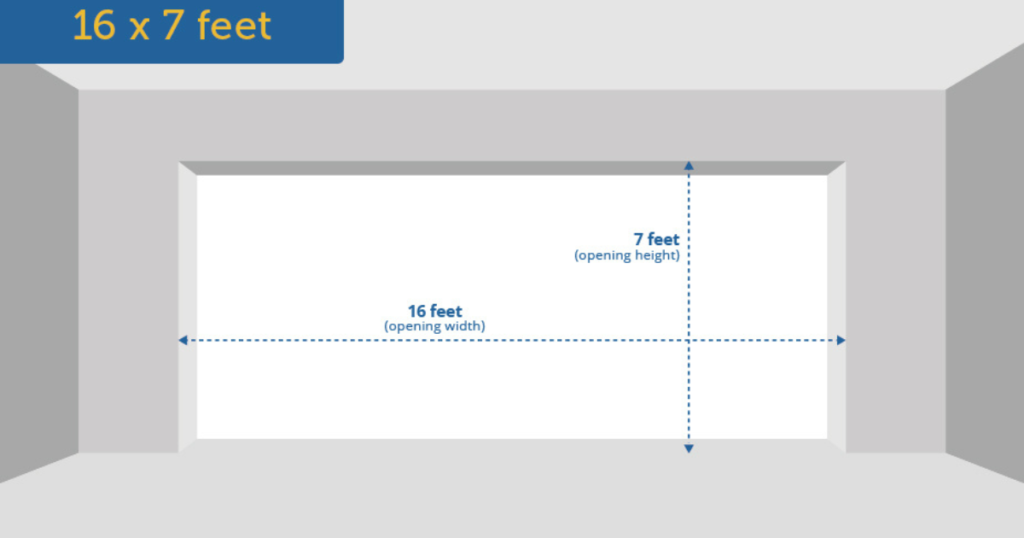Are you wondering “how wide is a single garage door” before purchasing a new one? Learn the standard sizes, measuring tips, and expert advice to ensure a perfect fit for your garage.
When shopping for a new garage door, one of the most common questions homeowners ask is, “How wide is a single garage door?” Knowing the correct dimensions can save you from costly installation errors and future regrets. It’s not just about fitting your vehicle; it’s about ensuring safety, ease of use, and the overall appearance of your home.
The width of a single garage door directly impacts how functional and practical your garage space will be. Whether you’re housing a compact car, a large SUV, or simply need additional storage space, selecting the proper size is crucial. Additionally, understanding standard garage door sizes helps when considering upgrades or property improvements.
We emphasize the importance of correct measurements before making any purchase decisions. Accurate sizing ensures that your investment delivers the convenience, security, and aesthetic value you expect from a new garage door.
Standard Dimensions: How Wide Is a Single Garage Door?
The most common width for a single garage door typically ranges between 8 to 10 feet. The standard height is usually 7 to 8 feet, but the width is where flexibility comes into play. Here’s what you need to know:
- 8 Feet Wide: This is the most basic size, commonly found in older homes or compact garages. It’s suitable for smaller vehicles such as compact cars, sedans, and some small crossover SUVs. It provides just enough clearance to park and exit the vehicle comfortably. Still, it may feel a bit tight if you’re maneuvering in a narrow driveway or want additional storage space along the walls.
- 9 Feet Wide: Considered the modern standard for many single garage doors, this width accommodates mid-sized vehicles like larger sedans, standard SUVs, and minivans. The extra foot of space provides more room for opening doors and maneuvering around the vehicle, which is especially beneficial for families or households with active lifestyles.
- 10 Feet Wide: This size is ideal for larger vehicles such as full-size SUVs, pickup trucks, or vans. It also offers added convenience if you frequently carry sports gear, tools, or other items that require more loading space. A 10-foot wide garage door provides a generous entryway, reducing the chance of accidental scrapes or dings and making it easier to back in or out.
Understanding how wide a single garage door is ensures that you choose the correct size based on your specific needs, whether it’s for a single vehicle or extra storage requirements.
Custom Garage Doors: When Standard Sizes Don’t Fit
Sometimes, standard sizes won’t meet your needs. If you own an oversized vehicle, recreational equipment, or prefer a wider entrance, custom sizing is the best option for you. Custom single garage doors can be designed in widths of up to 12 feet or more, providing you with maximum flexibility.
Keep in mind that a custom garage door typically involves additional costs, both in manufacturing and installation. Consulting a professional service like Rowlett Garage Door and Gates can help you decide if a standard or custom-sized door is the best investment for your property.

How to Measure Your Garage Door Opening Correctly
Before you purchase a new door, you need to measure accurately. Here’s how you can do it:
- Width (Opening Width)
Start by measuring the width of the garage door opening at its widest point — from the inside of one side jamb to the inside of the opposite side jamb. Take this measurement near the floor, in the middle, and at the top to ensure consistency. Use the largest of the three measurements as your final width.
- Height (Opening Height)
Measure the height from the finished floor to the underside of the header (the top of the garage opening). Like the width, check multiple points to confirm the measurement is even across the opening. Irregularities could indicate a need for leveling or framing adjustments.
- Side Room (Side Clearance)
Measure the space available on both the left and right sides of the garage door opening — from the edge of the opening to the nearest obstruction (like a wall or pipe). At least 3.5 inches is typically required on each side for standard vertical track systems; however, some doors or hardware may require more.
- Headroom (Top Clearance)
Headroom refers to the vertical space between the top of the garage door opening and the ceiling or any overhead obstructions, such as beams, pipes, or ducts. This space is crucial for the door hardware, especially the tracks and springs. Standard garage doors usually require 10 to 12 inches of headroom, though low-headroom kits are available for tighter spaces.
- Backroom (Depth of Garage)
Don’t forget to measure the depth of your garage from the opening toward the back wall. This is important to ensure that there is enough space for the door to retract fully along the ceiling when open. Typically, you’ll need the door height plus an additional 18 inches or more for proper operation.
Accurate measurements are the foundation of a smooth and safe garage door installation. If you’re uncertain at any step or encounter unusual framing or obstructions, it’s best to consult with professionals. The experienced team at Rowlett Garage Door and Gates is always available to help you take exact measurements and recommend the best door options to suit your space and style.
Factors to Consider When Choosing the Width of Your Garage Door
Choosing the right garage door width goes beyond just vehicle size. Consider the following:
Future Vehicle Purchases
Your current vehicle may fit comfortably, but what about your next one? If you’re planning to upgrade to a larger SUV, truck, or electric vehicle — many of which tend to be wider and taller — opting for a 9- or 10-foot-wide door now can prevent costly upgrades later. Future-proofing your garage helps avoid limitations down the road.
Storage Needs
Many homeowners use their garages for more than just parking. If you store bicycles, gardening tools, seasonal decorations, sports equipment, or workbenches, having a wider door can provide better access and flexibility. It also makes it easier to bring items in and out without moving your vehicle each time.
Ease of Parking
A wider new garage door can make daily parking significantly more convenient, especially for new drivers, those with limited mobility, or families with multiple drivers. More space allows for better visibility, easier maneuvering, and reduced risk of scratching the sides of your vehicle or damaging mirrors when pulling in or out.
Home Value and Curb Appeal
A garage door is one of the most visible elements of your home’s exterior. Selecting a properly sized and well-designed door can significantly enhance your home’s curb appeal and potentially increase its resale value. A door that fits well within the frame and complements your home’s architectural style gives a polished, upscale appearance.
Local Building Codes and HOA Guidelines
In some communities, homeowners’ associations (HOAs) or local building codes may dictate the permitted garage door sizes and styles. Always check these requirements before making a final decision, especially if you’re widening an existing garage opening.
Understanding how wide a single garage door is within these contexts ensures that you make a decision that’s right for both today and tomorrow.
Common Garage Door Styles and Their Size Options
The style of your new garage door can also affect your size choices. Common styles include:
Traditional Raised-Panel Doors
These are the most common and widely recognized garage doors, featuring symmetrical rectangular panels. They are highly versatile and usually available in all standard widths, including 8, 9, and 10 feet for single-car garages. This style suits most home types, offering a balanced mix of function and curb appeal.
Carriage-House Style
Inspired by old-fashioned barn or carriage house doors, these doors offer a charming, rustic look with decorative hardware and a swing-out visual design (although they open overhead, similar to modern doors). Carriage-house styles are often customizable, and many manufacturers offer wider size options to accommodate larger garages or enhance visual impact on the front of the home.
Modern Flush Panels
With sleek, flat surfaces and clean lines, modern flush-panel garage doors are ideal for contemporary homes. Their minimalist design complements modern architecture and is often paired with materials like glass, aluminum, or smooth steel. These doors usually come in flexible sizing, including wider or taller formats to match the bold proportions of today’s modern builds.
Full-View Glass Doors
Popular in modern and transitional homes, full-view doors feature large glass panels framed in aluminum or steel, allowing for a seamless view. These are often custom-sized, making them an excellent choice for oversized single garages or where natural light and aesthetics are top priorities.
Choosing the right style with the correct width can enhance the look of your home while providing optimal functionality. Explore your options with New Garage Door Installation at Rowlett Garage Door.

FAQs About How Wide Is a Single Garage Door
What is the average width of a single garage door?
The average width for a single garage door is between 8 to 9 feet, but it can go up to 10 feet depending on your needs.
Can I install a 12-foot-wide single garage door?
Yes, you can opt for a custom-made 12-foot-wide garage door if you have a larger vehicle or specific storage needs.
Is a 9-foot garage door wide enough for an SUV?
Yes, a 9-foot wide door typically accommodates most SUVs comfortably.
How much headroom do I need for a garage door installation?
Most standard garage doors require at least 12 inches of headroom, but specific measurements can vary based on door type and opener system.
Can I replace my old garage door with a wider one?
In many cases, yes, but it may require structural modifications. Consult with Rowlett Garage Door and Gates experts for a professional evaluation.
Conclusion
Choosing the right garage door size is more important than you initially think. Being aware of how wide a single garage door is can help you avoid costly mistakes and ensure that your new door fits perfectly and functions seamlessly. Whether you’re replacing an old door or installing a new one, precise measurement is key.
Working with professional garage door installers like Rowlett Garage Door and Gates ensures that your project goes smoothly from start to finish. Our team will help you select the ideal door size, style, and features that best fit your home and lifestyle.
Don’t leave such a significant home improvement decision to guesswork. Contact us today and let our experienced team guide you through every step of the process, from measurement to installation.
End Note
Rowlett Garage Door and Gates understands that garage door problems don’t always happen at convenient times. Whether it’s during late-night hours or amidst bad weather, we know the importance of immediate, expert help. That’s why we always recommend contacting our Garage Doors Service team as soon as you notice an issue.
If you need specialized assistance, whether it’s Commercial Garage Doors or New Garage Door Installation, we’re ready to serve you. We also provide services in Rockwall and Sherman areas, ensuring that our neighbors receive the reliable help they need when they need it most.
Learn more about our services by visiting our About Us page or get your questions answered on our Q&A page. Ready to get started? Contact us today and let Rowlett Garage Door and Gate help you with all your garage door needs!

